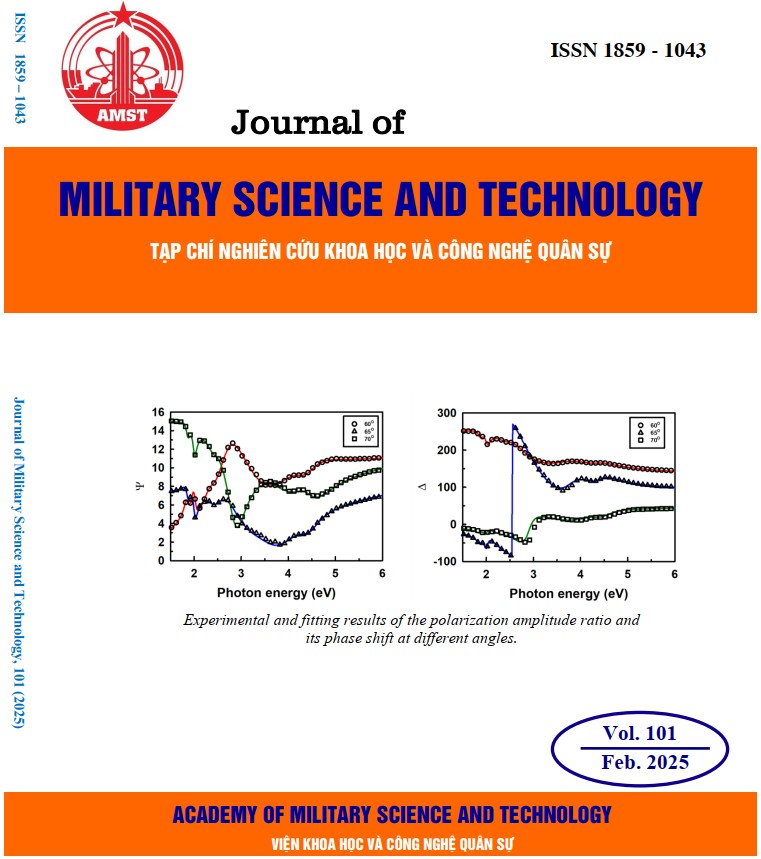Decomposition of methyl orange by Heterogeneous Electro-Fenton technology using ferrimagnetic oxide on activated carbon support as the catalyst
365 viewsDOI:
https://doi.org/10.54939/1859-1043.j.mst.101.2025.81-87Keywords:
Heterogeneous Electro-Fenton; Methyl orange; Magnetic activated carbon.Abstract
The treatment of methyl orange in this study was carried out by application of Electro-Fenton process using Fe3O4/AC catalyst and electrode cells in an area of 100 cm2. The efficiency of removing methyl orange was 98.86% with optimal conditions including: pH of solution 3.0, potential difference between two electrodes 15 V, initial concentration of methyl orange 20 ppm, catalyst dosage 0.8 g/L. The synthesized material has the ability to be reused, achieving the treatment efficiency of 78.5% after 4 reuses. The experimental results showed the potential of application the heterogeneous Electro-Fenton process for treatment of persistent organic compounds.
References
[1]. Farhan H.M and Norzahir S, "A review on the water problem associate with organic pollutants derived from phenol, methyl orange, and remazol brilliant blue dyes", Materials Today: Proceedings, Vol 31, pp. A141-A150, (2020), https://doi.org/10.1016/j.matpr.2021.01.258. DOI: https://doi.org/10.1016/j.matpr.2021.01.258
[2]. Kumar D.S, Khairul A.M, Jamil A, Elias M, and Mahiuddin M, "Removal of toxic methyl orange by a cost-free and eco-friendly adsorbent: Mechanism, phytotoxicity, thermodynamics, and kinetics", South African Journal of Chemical Engineering, Vol 40, pp. 195-208, (2022), https://doi.org/10.1016/j.sajce.2022.03.006. DOI: https://doi.org/10.1016/j.sajce.2022.03.006
[3]. Iwuozor K.O, Ighalo J.O, Chizitere E.E, Adewale O.L, and Adaobi I.C, "Adsorption of methyl orange: A review on adsorbent performance", Current Research in Green and Sustainable Chemistry, Vol 4, pp. 100179, (2021), https://doi.org/10.1016/j.crgsc.2021.100179. DOI: https://doi.org/10.1016/j.crgsc.2021.100179
[4]. Sifani Z, Tasneem E, Nourhan I, Mona G, Hyunwoong P, and Dong S.H, "Degradation of organic methyl orange (MO) dye using a photocatalyzed non-ferrous Fenton reaction", Nanomaterials, Vol 13(4), pp. 639, (2023), https://doi.org/10.3390/nano13040639. DOI: https://doi.org/10.3390/nano13040639
[5]. Zhang Z, Wang G, Li W, Zhang L, Chen T, and Ding L, "Degradation of methyl orange through hydroxyl radical generated by optically excited biochar: Performance and mechanism", Colloids and Surfaces A: Physicochemical and Engineering Aspects, Vol 601, pp. 125034, (2020), https://doi.org/10.1016/j.colsurfa.2020.125034. DOI: https://doi.org/10.1016/j.colsurfa.2020.125034
[6]. Abderrazzak A, Ouadrhiri F.E, Kara M, Ibtissam E.M, Amine A, Almutairi M.H, Roula B, Hanan M.R, Ilaria P, and Noureddine E, "Decolorization and degradation of methyl orange azo dye in aqueous solution by the electro fenton process: Application of optimization", Catalysts, Vol 12(6), pp. 665, (2022), https://doi.org/10.3390/catal12060665. DOI: https://doi.org/10.3390/catal12060665
[7]. Tu S, Ning Z, Duan X, Zhao X, and Chang L, "Efficient electrochemical hydrogen peroxide generation using TiO2/rGO catalyst and its application in electro-Fenton degradation of methyl orange", Colloids and Surfaces A: Physicochemical and Engineering Aspects, Vol 651, pp. 129657, (2022), https://doi.org/10.1016/j.colsurfa.2022.129657. DOI: https://doi.org/10.1016/j.colsurfa.2022.129657
[8]. Nguyen V.Linh, Ngo V.T.Huy, Nguyen T.Thuy, Nguyen T.Tung, Tran A.Khoi, and Le A.Kien, "Optimization of 4-chlorophenol decomposition by H2O2 activate catalytic magnetic iron oxide an activated carbon carrier", Journal of Military Science and Technology, Vol 97, pp. 96-104, (2024), https://doi.org/10.54939/1859-1043.j.mst.97.2024.96-104. DOI: https://doi.org/10.54939/1859-1043.j.mst.97.2024.96-104
[9]. Qiang L, Shiming X, Wu X, Wang S, Dongxu J, Wang P, Debing W, and Dong F, "Degrade methyl orange by a reverse electrodialysis reactor coupled with electrochemical direct oxidation and electro-Fenton processes", Electrocatalysis, Vol 13(3), pp. 242-254, (2022), https://doi.org/10.1007/s12678-022-00712-y. DOI: https://doi.org/10.1007/s12678-022-00712-y
[10]. Yakup E, "Nutrition design modeling method development for structural and elemental analysis of bertİz grape pekmez using field emission gun–scanning electron microscope (FEG-SEM)", Kahramanmaraş Sütçü İmam Üniversitesi Mühendislik Bilimleri Dergisi, Vol 26(4), pp. 796-800, (2023), https://doi.org/10.17780/ksujes.1267042. DOI: https://doi.org/10.17780/ksujes.1267042
[11]. Siti F, Risti R, Fitria A.H.D, and Dani A.B, "How to calculate crystallite size from x-ray diffraction (XRD) using Scherrer method", ASEAN Journal of Science and Engineering, Vol 2(1), pp. 65-76, (2022), https://ejournal.kjpupi.id/index.php/ajse/article/view/283.
[12]. Tun H and Chen C, "Isosteric heat of adsorption from thermodynamic Langmuir isotherm", Adsorption, Vol 27(6), pp. 979-989, (2021), https://doi.org/10.1007/s10450-020-00296-3. DOI: https://doi.org/10.1007/s10450-020-00296-3
[13]. Meyerstein D, "Re-examining Fenton and Fenton-like reactions", Nature Reviews Chemistry, Vol 5(9), pp. 595-597, (2021), https://doi.org/10.1038/s41570-021-00310-4. DOI: https://doi.org/10.1038/s41570-021-00310-4
[14]. Zhang S, Meng S, Tayler H, Akshay D, Zhou X, Seunghyun W, Elimelech M, and Kim J.H, "Mechanism of heterogeneous Fenton reaction kinetics enhancement under nanoscale spatial confinement", Environmental Science & Technology, Vol 54(17), pp. 10868-10875, (2020), https://doi.org/10.1021/acs.est.0c02192. DOI: https://doi.org/10.1021/acs.est.0c02192
[15]. Yong L, Yang Z, and Wang J, "Fenton/Fenton-like processes with in-situ production of hydrogen peroxide/hydroxyl radical for degradation of emerging contaminants: Advances and prospects", Journal of Hazardous Materials, Vol 404, pp. 124191, (2021), https://doi.org/10.1016/j.jhazmat.2020.124191. DOI: https://doi.org/10.1016/j.jhazmat.2020.124191
[16]. Yan Q, Zhang J, and Xing M, "Cocatalytic Fenton reaction for pollutant control", Cell Reports Physical Science, Vol 1 (8), (2020), https://www.cell.com/cell-reports-physical-science/fulltext/S2666-3864(20)30153-3. DOI: https://doi.org/10.1016/j.xcrp.2020.100149







